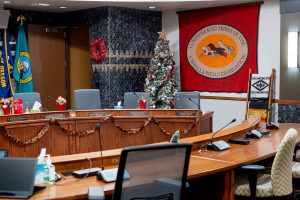BY CHRIS AADLAND
Reporter
MISSION, Ore. – Tribal leaders reviewed the findings of a report on Thursday that laid out several options for adding grades kindergarten through eighth at the Nixyaawii Community School, but didn’t leave them in a position to decide whether to say whether they will officially pursue expansion anytime soon.
Earlier in 2023, the Confederated Tribes of the Umatilla Indian Reservation hired a consulting firm, the Native-owned Wenaha Group, to study the feasibility of expanding grades taught at the school to give CTUIR youth and families the option of being educated by the tribal community — a longtime goal of tribal leaders – for their entire primary education journey.
The consultants presented their findings to the Board of Trustees during a Nov. 9 work session, which included several options the tribe could pursue to expand the school.
Given the several options and steps required for each, and other unanswered questions, like the lack of a long-term solution to address early childhood education and daycare needs being included in the report, BOT members said they didn’t have enough information to say whether they favored expansion at the meeting.
Instead, tribal leaders indicated that they will likely form a task force to spend 2024 further reviewing the options before recommending whether to expand the tribe’s educational offerings.
If the tribe ultimately chooses to add more grades, it’ll likely take several years – sometime between 2027 and 2030, the report estimated – and millions of dollars in construction costs before additional students can begin attending.
“Bottom line: We still have a lot of work to do,” BOT Chair Kat Brigham said at the meeting. “We definitely need to be figuring what our next steps are and how we’re going to be moving forward, because, as some of our elders have told me … we definitely need to grow our own.”
The 64,000 square foot school building currently operates as a high school for grades 9 through 12 under a Pendleton School District charter. The building and charter allows for up to 200 students, though about 75-85 have typically enrolled at NCS.
It also houses the CTUIR Language, Head Start and daycare programs.
In the report to the BOT, consultants presented four options – making no changes to grades offered at NCS under the charter; making no changes but increasing other programming, like after school and early childhood, offerings; expanding the building and offering more grades under a modified charter agreement; or expanding while pursuing several self-governing operation models.
The report also included options for fully expanding to k-8, phasing those grades in, or only partially expanding to include some grades.
Depending on what approach the tribe settled on, the consultants estimated that construction-related costs would range from about $24.1 million to $40 million, with yearly operational costs of between approximately $1.5 million and $3.2 million.
The consulting firm also presented four governance, or oversight, options that would affect how much the tribe would pay to build and operate the expanded school, as well as how much control over curriculum, staffing and other programming, it would have.
The tribe could seek to modify its charter with the Pendleton School District to include more grades and continue under the same funding mix of state taxes, federal and state grants and tribal dollars.
Or it could lobby for policy changes at the state level, sign a compact with the state, and break away from the Pendleton charter to essentially become a self-governing school district, according to the Thursday presentation.
It could also operate under two models to partner with the Bureau of Indian Education, the consultants said. Both options would give the tribe greater control in determining things like curriculum and programming, because, they said, the BIE values things — like incorporating Indigenous language and culture in education — more than states.
Those approaches would require less funding from the tribe and be paid for mostly through federal grants, the consultants said in their report.
If tribal leaders settle on a fourth option – forming an entirely self-funded and governed district – that some BOT members said they preferred, CTUIR would have to pay for all construction and operational costs but would result in the greatest control of how it educates it students compared to the other suggestions.
Not included in the findings was information about, as some BOT members said, options for how the tribe could address CTUIR’s pre-kindergarten and childcare needs, as well as estimates on how many students would ultimately choose to attend NCS if additional grades were offered.
The next step will likely include forming a task force to further study the issue and recommend how to proceed in the next year, though no formal directive was drafted at the meeting for the BOT to act on at its upcoming meeting on Nov. 13.
Some BOT members said a task force, and any recommendations produced by it, should include further discussion about a long-term vision about an early-childhood education and daycare and how to incorporate that into any potential k-8 expansion.
Regardless of how the tribe ultimately decides how to proceed — and when — its charter agreement with Pendleton will soon need to be addressed, as it expires in 2024.
The CUJ will update this story with additional feedback and information from the report for the newspaper’s December print edition.




